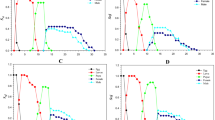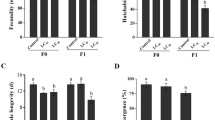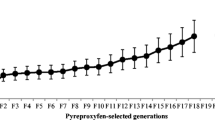Abstract
Musca domestica is a global insect-pest of human beings and animal agriculture. Pyriproxyfen, a juvenile hormone analog, has shown its potential for effective management of M. domestica. However, lethal and sublethal effects of pyriproxyfen on biological traits and demographic growth parameters of M. domestica are still unknown. The present study investigated the effects of lethal and sublethal concentrations on different biological traits of M. domestica for two generations i.e., exposed parents (F0) and their offspring (F1). Concentration-response bioassays revealed that concentrations of pyriproxyfen that caused 50% (LC50), 25% (LC25), 10% (LC10) and 2% (LC2) mortality of M. domestica were estimated as 0.12, 0.06, 0.03 and 0.01 μg/g, respectively. In the F0 generation, exposure of 3rd instar larvae to these concentrations resulted in a reduced pupation rate, lengthened pupal stage duration, light weight pupae and reduction in adult emergence in a concentration-dependent manner. In the case of F1 generation, similar trend was observed for pupation rate, pupal stage duration, and total developmental period (i.e., egg to adult); however, pupal weight was affected at LC10, LC25, LC50 levels, and adult emergence at only LC25 and LC50 levels. The values of demographic growth parameters, analyzed through age-stage, two-sex life table theory, were significantly decreased at all the levels of pyriproxyfen compared with control. This study highlights that pyriproxyfen has the potential to suppress the population of M. domestica through its lethal and sublethal effects and presents an empirical basis from which to consider management decisions for chemical control in the field.










Similar content being viewed by others
References
Abd Allah A, Desneux N, Fan Y, Han P, Ali A, Song D, Gao X-W (2018) Impact of imidacloprid and natural enemies on cereal aphids: integration or ecosystem service disruption? Entomol Gen 37:047–061
Akca I, Ayvaz T, Yazici E, Smith CL, Chi H (2015) Demography and population projection of Aphis fabae (Hemiptera: Aphididae): with additional comments on life table research criteria. J Econ Entomol 108:1466–1478
Akköprü EP, Atlıhan R, Okut H, Chi H (2015) Demographic assessment of plant cultivar resistance to insect pests: a case study of the dusky-veined walnut aphid (Hemiptera: Callaphididae) on five walnut cultivars. J Econ Entomol 108:378–387
Alizadeh M, Karimzadeh J, Rassoulian G, Farazmand H, Hoseini-Naveh V, Pourian H (2012) Sublethal effects of pyriproxyfen, a juvenile hormone analogue, on Plutella xylostella (Lepidoptera: Plutellidae): life table study. Arch Phytopathol Plant Protect 45:1741–1763
Beggel S, Werner I, Connon RE, Geist JP (2010) Sublethal toxicity of commercial insecticide formulations and their active ingredients to larval fathead minnow (Pimephales promelas). Sci Total Environ 408:3169–3175
Biale H, Chiel E, Geden CJ (2019) Autodissemination of pyriproxyfen as a method for controlling the house fly Musca domestica. J Pest Sci 92:1283–1292
Biale H, Geden CJ, Chiel E (2017) Effects of pyriproxyfen on wild populations of the housefly, Musca domestica, and compatibility with its principal parasitoids. Pest Manage Sci 73:2456–2464
Biondi A, Desneux N, Siscaro G, Zappalà L (2012) Using organic-certified rather than synthetic pesticides may not be safer for biological control agents: selectivity and side effects of 14 pesticides on the predator Orius laevigatus. Chemosphere 87:803–812
Blagburn BL, Dryden MW (2009) Biology, treatment, and control of flea and tick infestations Veterinary. Clinics: Small Animal Practice 39:1173–1200
Calabrese EJ, Baldwin LA (2001) Hormesis: a generalizable and unifying hypothesis. Crit Rev Toxicol 31:353–424
Chen TY, Liu TX (2002) Susceptibility of immature stages of Chrysoperla rufilabris (Neurop., Chrysopidae) to pyriproxyfen, a juvenile hormone analog. J Appl Entomol 126:125–129
Chi H (1988) Life-table analysis incorporating both sexes and variable development rates among individuals. Environ Entomol 17:26–34
Chi H (2020) TWOSEX-MSChart: a computer program for the age tage, two sex life table analysis. National Chung Hsing University, Taichung, Taiwan
Chi H, Liu H (1985) Two new methods for the study of insect population ecology. Bull Inst Zool Acad Sin 24:225–240
Chi H, Su H-Y (2006) Age-stage, two-sex life tables of Aphidius gifuensis (Ashmead)(Hymenoptera: Braconidae) and its host Myzus persicae (Sulzer)(Homoptera: Aphididae) with mathematical proof of the relationship between female fecundity and the net reproductive rate. Environ Entomol 35:10–21
Chi H et al. (2020) Age-Stage, two-sex life table: an introduction to theory, data analysis, and application. Entomol Gen 40:103–124
Cordeiro E, De Moura I, Fadini M, Guedes R (2013) Beyond selectivity: are behavioral avoidance and hormesis likely causes of pyrethroid-induced outbreaks of the southern red mite Oligonychus ilicis? Chemosphere 93:1111–1116
Cousins M, Sargeant JM, Fisman D, Greer AL (2019) Modelling the transmission dynamics of Campylobacter in Ontario, Canada, assuming house flies, Musca domestica, are a mechanical vector of disease transmission. R Soc Open Sci 6:181394
Deacutis JM, Leichter CA, Gerry AC, Rutz DA, Watson WD, Geden CJ, Scott JG (2006) Susceptibility of field collected house flies to spinosad before and after a season of use. J Agric Urban Entomol 23:105–110
Deng D et al. (2019) Assessment of the effects of lethal and sublethal exposure to dinotefuran on the wheat aphid Rhopalosiphum padi (Linnaeus). Ecotoxicology 28:825–833
Desneux N, Decourtye A, Delpuech J-M (2007) The sublethal effects of pesticides on beneficial arthropods. Annu Rev Entomol 52:81–106
Desneux N, Fauvergue X, Dechaume-Moncharmont F-X, Kerhoas L, Ballanger Y, Kaiser L (2005) Diaeretiella rapae limits Myzus persicae populations after applications of deltamethrin in oilseed rape. J Econ Entomol 98:9–17
Efron B, Tibshirani RJ (1994) An introduction to the bootstrap. Chapman and Hall, CRC Press, New York, NY
Fiaz M et al. (2019) Pyriproxyfen, a juvenile hormone analog, damages midgut cells and interferes with behaviors of Aedes aegypti larvae. PeerJ 7:e7489
Finney D (1971) A statistical treatment of the sigmoid response curve Probit analysis, 3rd edn. Cambridge University Press, London, p 333
Fisher R (1930) The genetical theory of natural selection: a complete variorum edition. J. H. Bennett (ed.). Oxford University Press, Oxford
Francesena N, Schneider MI (2018) Selectivity assessment of two biorational insecticides, azadirachtin and pyriproxyfen, in comparison to a neonicotinoid, acetamiprid, on pupae and adults of a Neotropical strain Eretmocerus mundus. Mercet Chemosphere 206:349–358
Geden CJ, Devine GJ (2012) Pyriproxyfen and house flies (Diptera: Muscidae): effects of direct exposure and autodissemination to larval habitats. J Med Entomol 49:606–613
Gerry AC, Zhang D (2009) Behavioral resistance of house flies, Musca domestica (Diptera: Muscidae) to imidacloprid US Army Medical Department Journal
Goodman D (1982) Optimal life histories, optimal notation, and the value of reproductive value. Am Nat 119:803–823
Guo L, Desneux N, Sonoda S, Liang P, Han P, Gao X-W (2013) Sublethal and transgenerational effects of chlorantraniliprole on biological traits of the diamondback moth. Plutella xylostella L Crop Protect 48:29–34
Harburguer L, Zerba E, Licastro S (2014) Sublethal effect of pyriproxyfen released from a fumigant formulation on fecundity, fertility, and ovicidal action in Aedes aegypti (Diptera: Culicidae). J Med Entomol 51:436–443
Iftikhar A et al. (2020) Sublethal effects of a juvenile hormone analog, Pyriproxyfen on demographic parameters of non-target predator, Hippodamia convergens Guerin-Meneville (Coleoptera: Coccinellidae). Ecotoxicology 29:1017–1028
Ishaaya I, Horowitz AR (1995) Pyriproxyfen, a novel insect growth regulator for controlling whiteflies: mechanisms and resistance management. Pestic Sci 43:227–232
Izadi H, Sarnevesht M, Sadeghi R, Mahdian K, Jalai MA (2012) Toxic effects of pyriproxyfen, neemarin, acetamiprid and Ferula assafoetida essential oil on the common pistachio psylla. Agonoscena pistaciae Arch Phytopathol Plant Protect 45:2236–2242
Joao Zotti M, Dionel Grutzmacher A, Heres Lopes I, Smagghe G (2013) Comparative effects of insecticides with different mechanisms of action on Chrysoperla externa (Neuroptera: Chrysopidae): Lethal, sublethal and dose–response effects. Insect Sci 20:743–752
Khan HA, Akram W, Shad SA (2013) Resistance to conventional insecticides in Pakistani populations of Musca domestica L. (Diptera: Muscidae): a potential ectoparasite of dairy animals. Ecotoxicology 22:522–527. https://doi.org/10.1007/s10646-013-1044-2
Khan HA, Shad SA, Akram W (2012) Effect of livestock manures on the fitness of house fly, Musca domestica L. (Diptera: Muscidae). Parasitol Res 111:1165–1171. https://doi.org/10.1007/s00436-012-2947-1
Khan HAA (2018) Spinosad resistance affects biological parameters of Musca domestica. Linnaeus Scientific reports 8:1–7
Khan HAA (2019) Realized heritability of resistance to deltamethrin in a field strain of Musca domestica Linnaeus (Diptera: Muscidae). Chemosphere 215:678–680
Khan HAA (2020a) Resistance to insecticides and synergism by enzyme inhibitors in Aedes albopictus from Punjab, Pakistan. Sci Reports 10:1–8
Khan HAA (2020b) Side effects of insecticidal usage in rice farming system on the non-target house fly Musca domestica in Punjab, Pakistan. Chemosphere 241:125056
Khan HAA (2020c) Susceptibility to indoxacarb and synergism by enzyme inhibitors in laboratory and field strains of five major stored product insects in Pakistan. Chemosphere 257:127167
Khan HAA, Akram W (2017) Cyromazine resistance in a field strain of house flies, Musca domestica L.: Resistance risk assessment and bio-chemical mechanism. Chemosphere 167:308–313
Khan HAA, Akram W (2018) Trichlorfon and spinosad resistance survey and preliminary determination of the resistance mechanism in Pakistani field strains of Bactrocera dorsalis. Scientific Reports 8:1–5
Khan HAA, Akram W, Ali S (2020) Activities of Select Enzymes Involved in Insecticide Resistance in Spinosad-Resistant and-Susceptible Strains of Musca domestica (Diptera: Muscidae). J Med Entomol 57:620–622
Khan HAA, Akram W, Arshad M, Hafeez F (2016) Toxicity and resistance of field collected Musca domestica (Diptera: Muscidae) against insect growth regulator insecticides. Parasitol Res 115:1385–1390
Khan HAA, Akram W, Haider MS (2015) Genetics and mechanism of resistance to deltamethrin in the house fly, Musca domestica L., from Pakistan. Ecotoxicology 24:1213–1220
Laroche L et al. (2020) Boosting the sterile insect technique with pyriproxyfen increases tsetse flies Glossina palpalis gambiensis sterilization in controlled conditions. Scientific reports 10:1–11
Liu T-X, Stansly PA (2004) Lethal and sublethal effects of two insect growth regulators on adult Delphastus catalinae (Coleoptera: Coccinellidae), a predator of whiteflies (Homoptera: Aleyrodidae). Biol Control 30:298–305
Liu TX (2003) Effects of a juvenile hormone analog, pyriproxyfen, on Thrips tabaci (Thysanoptera: Thripidae) Pest Management Science: formerly. Pesticide Science 59:904–912
Lu Y, Zheng X, Gao X (2016) Sublethal effects of imidacloprid on the fecundity, longevity, and enzyme activity of Sitobion avenae (Fabricius) and Rhopalosiphum padi (Linnaeus). Bull Entomol Res 106:551
Moadeli T, Hejazi M, Golmohammadi G (2018) Lethal effects of pyriproxyfen, spinosad, and indoxacarb and sublethal effects of pyriproxyfen on the 1st instars larvae of beet armyworm, Spodoptera exigua Hübner (Lepidoptera: Noctuidae) in the Laboratory
Neupane S, Nayduch D, Zurek L (2019) House Flies (Musca domestica) Pose a Risk of Carriage and Transmission of Bacterial Pathogens Associated with Bovine Respiratory Disease (BRD). Insects 10:358
Oouchi H (2005) Insecticidal properties of a juvenoid, pyriproxyfen, on all life stages of the diamondback moth, Plutella xylostella (Lepidoptera: Yponomeutidae). Appl Entomol Zool 40:145–149
Parreira DS et al. (2018) Essential oils cause detrimental effects on biological parameters of Trichogramma galloi immatures. J Pest Sci 91:887–895
Prabhaker N, Toscano NC (2007) Toxicity of the insect growth regulators, buprofezin and pyriproxyfen, to the glassy-winged sharpshooter, Homalodisca coagulata Say (Homoptera: Cicadellidae). Crop Protect 26:495–502
Qu Y et al. (2015) Sublethal and hormesis effects of imidacloprid on the soybean aphid Aphis glycines. Ecotoxicology 24:479–487
Reid B, Brock V, Bennett G (1994) Developmental, morphogenetic and reproductive effects of four poly cyclic Non-isoprenoid Juvenoids in the German Cockroach (Dictyoptera: Blattellidae). J Entomol Sci 29:31–42
Resmitha C, Meethal K (2016) Toxicity of insect growth regulator, pyriproxyfen, on larvae of Spodoptera mauritia Boisd.(Lepidoptera: Noctuidae). Int J Agric Innov Res 5:173–176
Schmuck R, Pflüger W, Grau R, Hollihn U, Fischer R (1994) Comparison of short-term aquatic toxicity: formulation vs active ingredients of pesticides. Arch Environ Contam Toxicol 26:240–250
Sial AA, Brunner JF (2010) Lethal and sublethal effects of an insect growth regulator, pyriproxyfen, on obliquebanded leafroller (Lepidoptera: Tortricidae). J Econ Entomol 103:340–347
Stark JD, Banks JE (2003) Population-level effects of pesticides and other toxicants on arthropods. Annu Rev Entomol 48:505–519
Tuan S-J, Lee C-C, Chi H (2014a) Population and damage projection of Spodoptera litura (F.) on peanuts (Arachis hypogaea L.) under different conditions using the age-stage, two-sex life table. Pest Manage Sci 70:1936–1936. https://doi.org/10.1002/ps.3920
Tuan SJ, Lee CC, Chi H (2014b) Population and damage projection of Spodoptera litura (F.) on peanuts (Arachis hypogaea L.) under different conditions using the age-stage, two-sex life table. Pest Manage Sci 70:805–813
Ullah F et al. (2019a) Acetamiprid-induced hormetic effects and vitellogenin gene (Vg) expression in the melon aphid, Aphis gossypii. Entomol Gen 39:259–270
Ullah F, Gul H, Desneux N, Tariq K, Ali A, Gao X, Song D (2019b) Clothianidin-induced sublethal effects and expression changes of vitellogenin and ecdysone receptors genes in the melon aphid, Aphis gossypii. Entomol Gen 39:137–149
Ullah F et al. (2019c) Impact of low lethal concentrations of buprofezin on biological traits and expression profile of chitin synthase 1 gene (CHS1) in melon aphid, Aphis gossypii. Scientific reports 9:1–13
Vennard C, Nguama B, Dillon H, Oouchi H, Charnley A (1998) Effects of the juvenile hormone mimic pyriproxyfen on egg development, embryogenesis, larval development, and metamorphosis in the desert locust Schistocerca gregaria (Orthoptera: Acrididae). J Econ Entomol 91:41–49
Wang S, Qi Y, Desneux N, Shi X, Biondi A, Gao X (2017) Sublethal and transgenerational effects of short-term and chronic exposures to the neonicotinoid nitenpyram on the cotton aphid Aphis gossypii. J Pest Sci 90:389–396
Yasoob H, Ali Khan HA, Zhang Y (2017) Toxicity and Sublethal Effects of Cantharidin on Musca domestica (Diptera: Muscidae). J Econ Entomol 110: 2539–2544
Zhang Y, Guo L, Atlihan R, Chi H, Chu D (2019) Demographic analysis of progeny fitness and timing of resurgence of Laodelphax striatellus after insecticides exposure. Entomol Gen 39:221–230
Zhang Y, Guo M, Ma Z, You C, Gao X, Shi X (2020) Esterase-mediated spinosad resistance in house flies Musca domestica (Diptera: Muscidae). Ecotoxicology 29:35–44
Acknowledgements
Sincere thanks to the laboratory staff for help in laboratory maintenance of insects and bioassays. The study was supported by the research funds of Institute of Agricultural Sciences, University of the Punjab, Lahore.
Author information
Authors and Affiliations
Corresponding author
Ethics declarations
Conflict of interest
The author declares no competing interests.
Ethical approval
This article does not describe any studies involving human participants performed by the authors. All applicable international, national and/or institutional guidelines for the care and use of animals were followed.
Additional information
Publisher’s note Springer Nature remains neutral with regard to jurisdictional claims in published maps and institutional affiliations.
Rights and permissions
About this article
Cite this article
Khan, H.A.A. Pyriproxyfen induces lethal and sublethal effects on biological traits and demographic growth parameters in Musca domestica. Ecotoxicology 30, 610–621 (2021). https://doi.org/10.1007/s10646-021-02394-6
Accepted:
Published:
Issue Date:
DOI: https://doi.org/10.1007/s10646-021-02394-6




